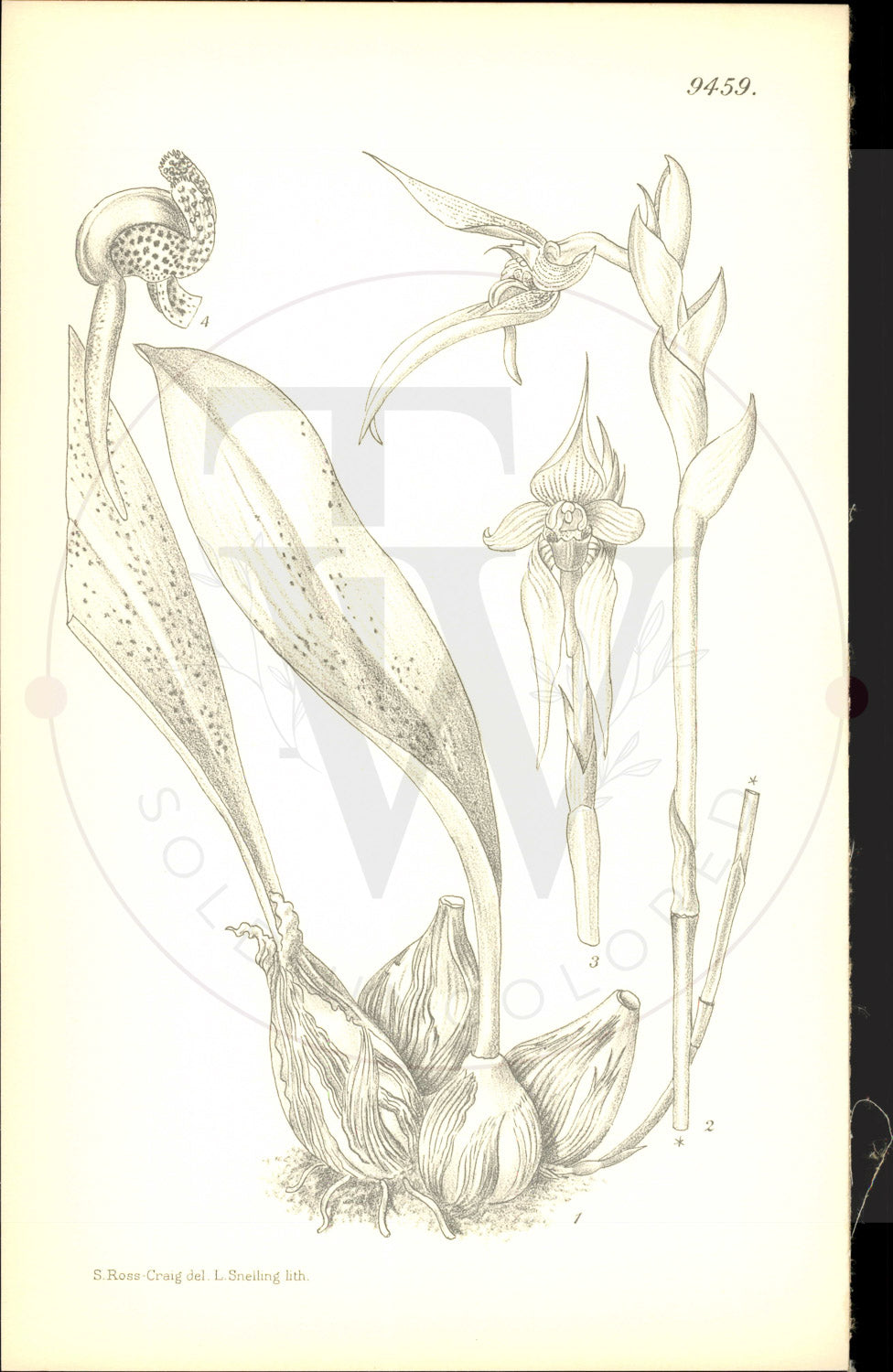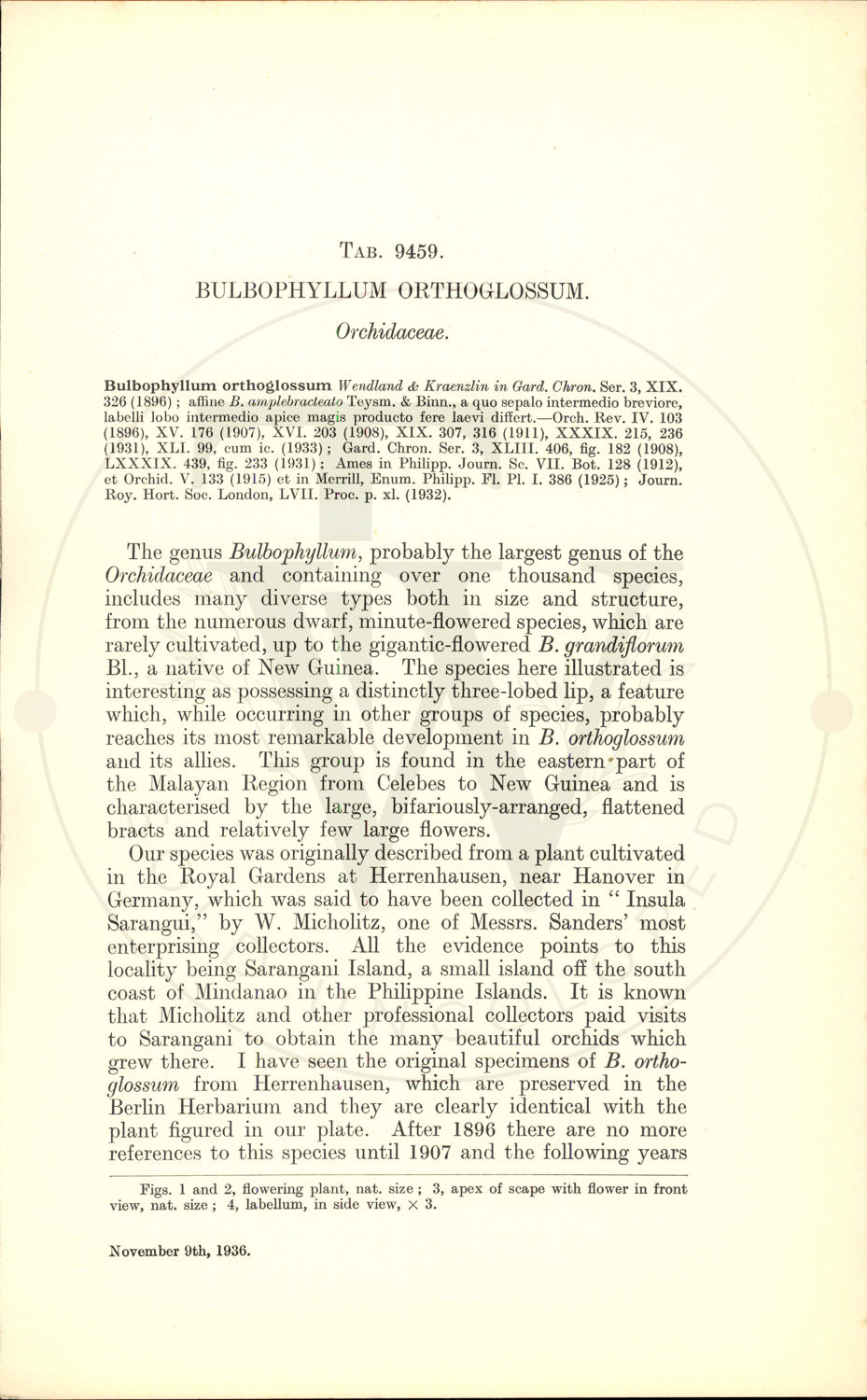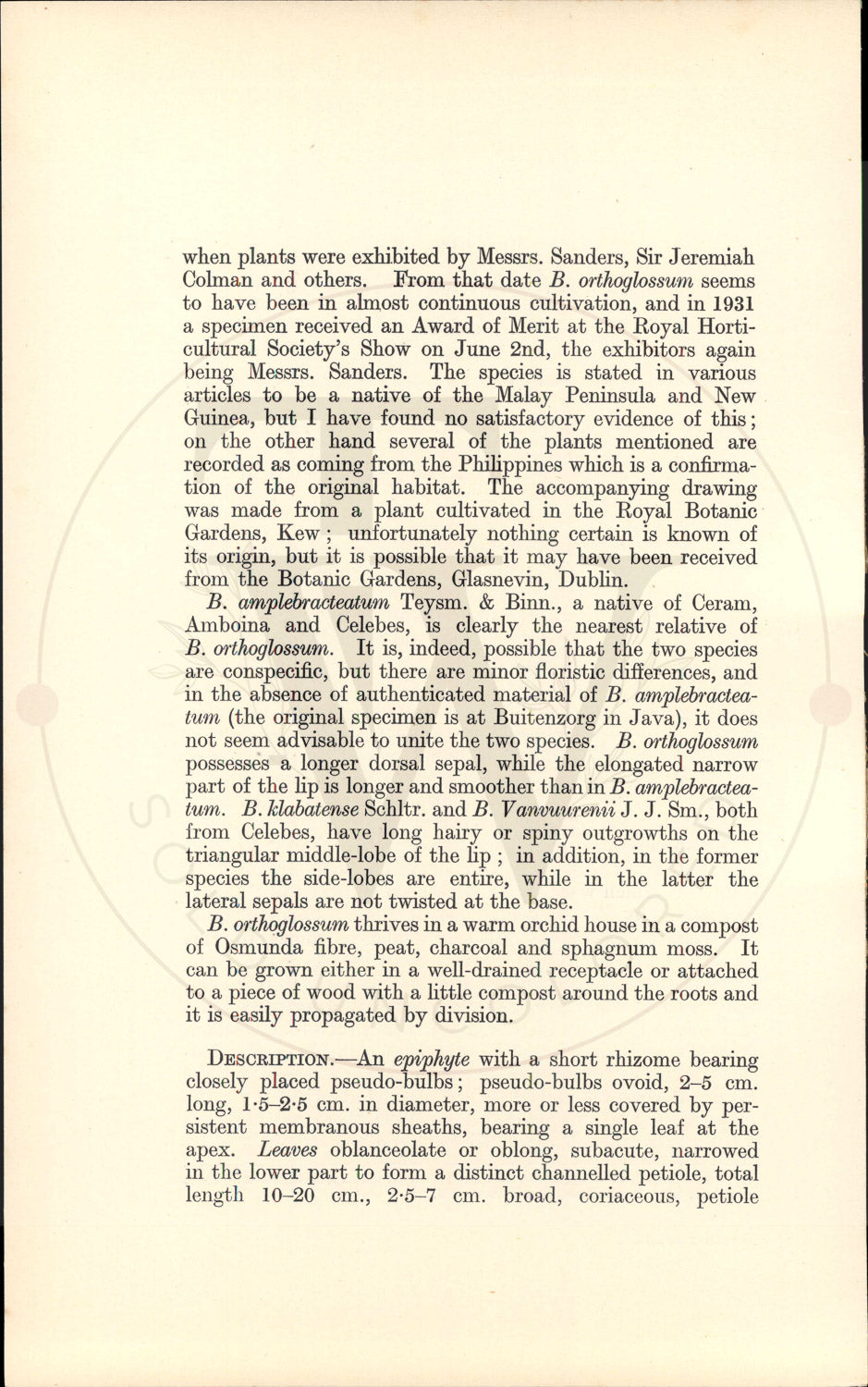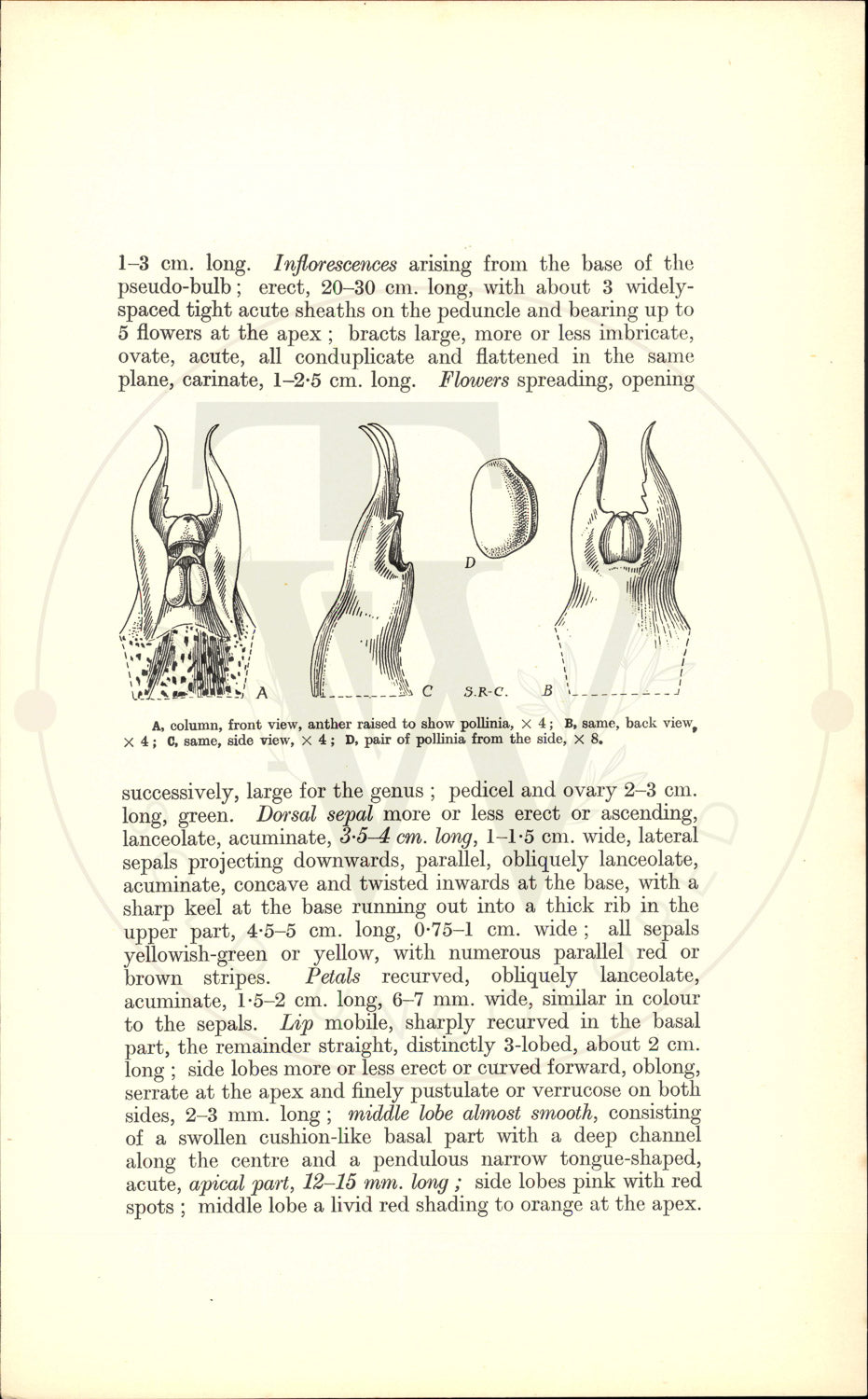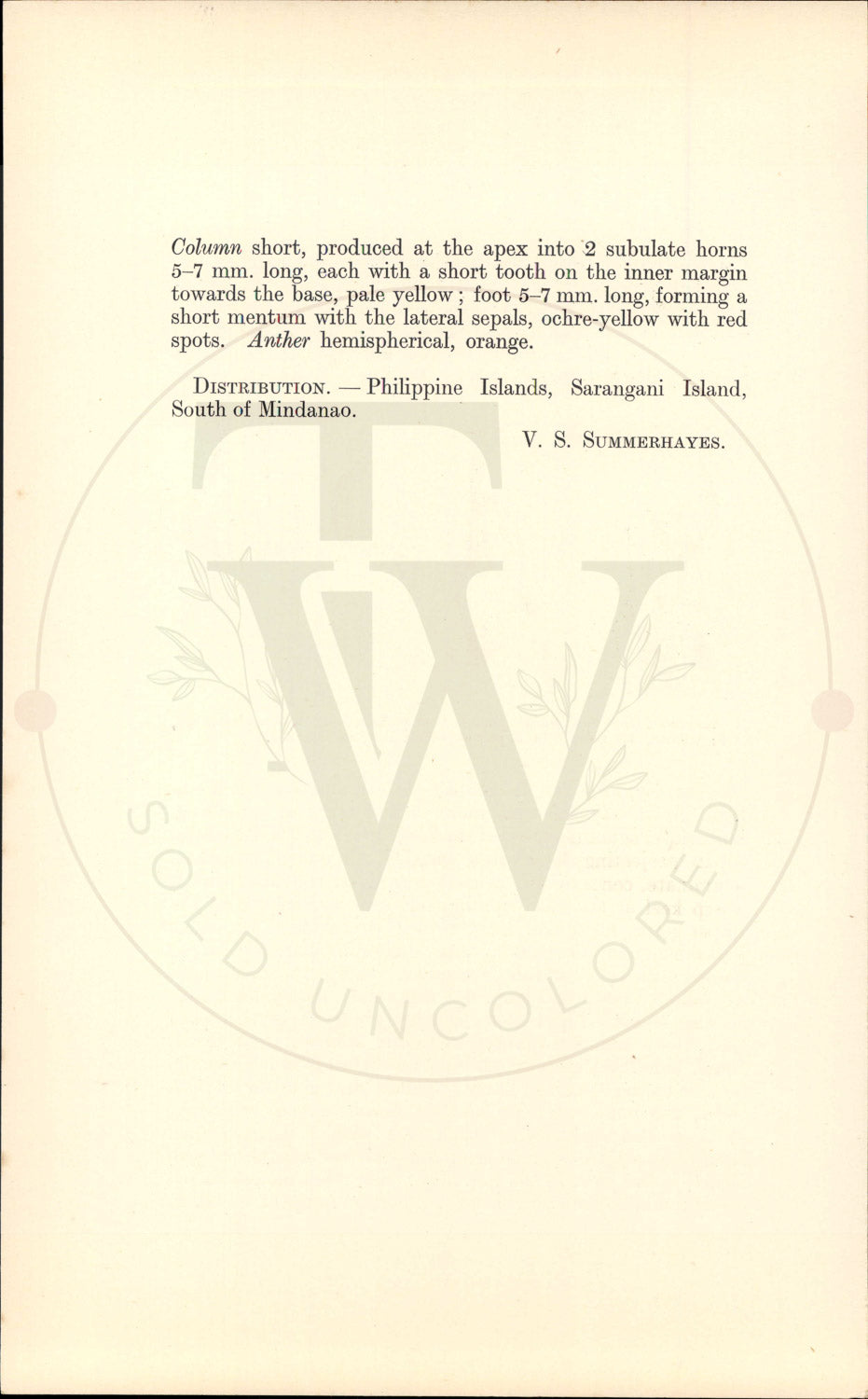Curtis Botanical Magazine
Plate 9459 - Bulbophyllum orthoglossum
Plate 9459 - Bulbophyllum orthoglossum
Couldn't load pickup availability
Curtis's Botanical Magazine - Plate 9459
Bulbophyllum orthoglossum
Publication Date: January 1st, 1934
Distribution: South of Mindanao • Tab Author: V. S. SUMMERHAYES
Botanical Description
Our species was originally described from a plant cultivated in the Royal Gardens at Herrenhausen, near Hanover in Germany, which was said to have been collected in "Insula Sarangui," by W. Micholitz, one of Messrs. Sanders' most enterprising collectors. All the evidence points to this locality being Sarangani Island, a small island off the south coast of Mindanao in the Philippine Islands. It is known that Micholitz and other professional collectors paid visits to Sarangani to obtain the many beautiful orchids which grew there. I have seen the original specimens of B. ortho- glossum from Herrenhausen, which are preserved in the Berlin Herbarium and they are clearly identical with the plant figured in our plate. After 1896 there are no more references to this species until 1907 and the following years Figs. 1 and 2, flowering plant, nat. size; 3, apex of scape with flower in front view, nat. size; 4, labellum, in side view, x 3. November 9th, 1936. when plants were exhibited by Messrs. Sanders, Sir Jeremiah Colman and others. From that date B. orthoglossum seems to have been in almost continuous cultivation, and in 1931 a specimen received an Award of Merit at the Royal Horti- cultural Society's Show on June 2nd, the exhibitors again being Messrs. Sanders. The species is stated in various articles to be a native of the Malay Peninsula and New Guinea, but I have found no satisfactory evidence of this; on the other hand several of the plants mentioned are recorded as coming from the Philippines which is a confirma- tion of the original habitat. The accompanying drawing was made from a plant cultivated in the Royal Botanic Gardens, Kew; unfortunately nothing certain is known of its origin, but it is possible that it may have been received from the Botanic Gardens, Glasnevin, Dublin. B. amplebracteatum Teysm. & Binn., a native of Ceram, Amboina and Celebes, is clearly the nearest relative of B. orthoglossum. It is, indeed, possible that the two species are conspecific, but there are minor floristic differences, and in the absence of authenticated material of B. amplebractea- tum (the original specimen is at Buitenzorg in Java), it does not seem advisable to unite the two species. B. orthoglossum possesses a longer dorsal sepal, while the elongated narrow part of the lip is longer and smoother than in B. amplebractea- tum. B. klabatense Schltr. and B. Vanvuurenii J. J. Sm., both from Celebes, have long hairy or spiny outgrowths on the triangular middle-lobe of the lip; in addition, in the former species the side-lobes are entire, while in the latter the lateral sepals are not twisted at the base. B. orthoglossum thrives in a warm orchid house in a compost of Osmunda fibre, peat, charcoal and sphagnum moss. It can be grown either in a well-drained receptacle or attached to a piece of wood with a little compost around the roots and it is easily propagated by division. DESCRIPTION. An epiphyte with a short rhizome bearing closely placed pseudo-bulbs; pseudo-bulbs ovoid, 2-5 cm. long, 1.5-2.5 cm. in diameter, more or less covered by per- sistent membranous sheaths, bearing a single leaf at the apex. Leaves oblanceolate or oblong, subacute, narrowed in the lower part to form a distinct channelled petiole, total length 10-20 cm., 2.5-7 cm. broad, coriaceous, petiole 1-3 cm. long. Inflorescences arising from the base of the pseudo-bulb; erect, 20-30 cm. long, with about 3 widely- spaced tight acute sheaths on the peduncle and bearing up to 5 flowers at the apex; bracts large, more or less imbricate, ovate, acute, all conduplicate and flattened in the same plane, carinate, 1-2.5 cm. long. Flowers spreading, opening D S.R-C. B A, column, front view, anther raised to show pollinia, x 4; B, same, back view, x 4; C, same, side view, x 4%; D, pair of pollinia from the side, x 8. successively, large for the genus; pedicel and ovary 2-3 cm. long, green. Dorsal sepal more or less erect or ascending, lanceolate, acuminate, 3.5-4 cm. long, 1-1.5 cm. wide, lateral sepals projecting downwards, parallel, obliquely lanceolate, acuminate, concave and twisted inwards at the base, with a sharp keel at the base running out into a thick rib in the upper part, 4.5-5 cm. long, 0.75-1 cm. wide; all sepals yellowish-green or yellow, with numerous parallel red or brown stripes. Petals recurved, obliquely lanceolate, acuminate, 1.5-2 cm. long, 6-7 mm. wide, similar in colour to the sepals. Lip mobile, sharply recurved in the basal part, the remainder straight, distinctly 3-lobed, about 2 cm. long; side lobes more or less erect or curved forward, oblong, serrate at the apex and finely pustulate or verrucose on both sides, 2-3 mm. long; middle lobe almost smooth, consisting of a swollen cushion-like basal part with a deep channel along the centre and a pendulous narrow tongue-shaped, acute, apical part, 12-15 mm. long; side lobes pink with red spots; middle lobe a livid red shading to orange at the apex. Column short, produced at the apex into 2 subulate horns 5-7 mm. long, each with a short tooth on the inner margin towards the base, pale yellow; foot 5-7 mm. long, forming a short mentum with the lateral sepals, ochre-yellow with red spots. Anther hemispherical, orange. DISTRIBUTION. South of Mindanao. Philippine Islands, Sarangani Island, V. S. SUMMERHAYES.
About This Print
Original black and white uncolored botanical print from Curtis's Botanical Magazine (established 1787). This 9000s series print is from unissued publisher stock, never hand-colored, representing the authentic plate as it appeared in the magazine. Edited by Sir Arthur William Hill for The Royal Horticultural Society, London.
Share
